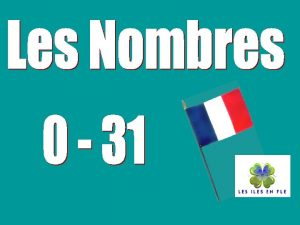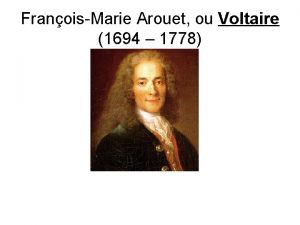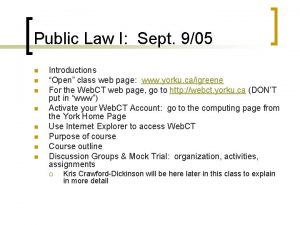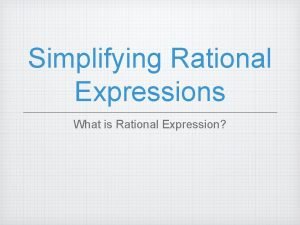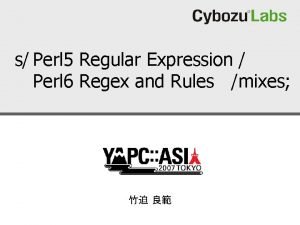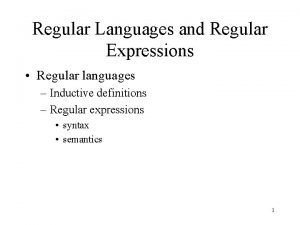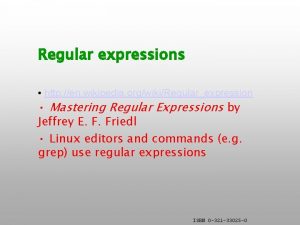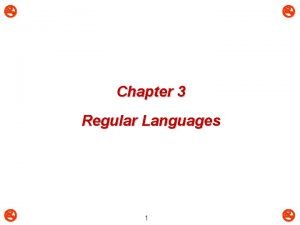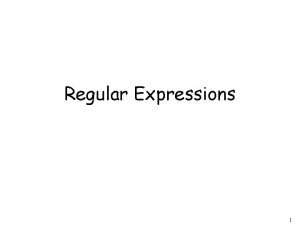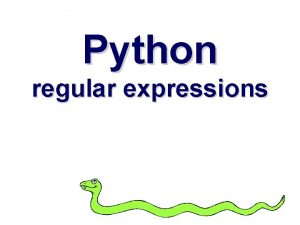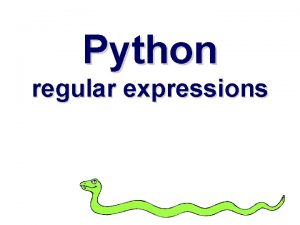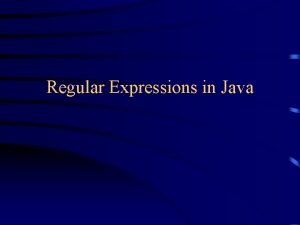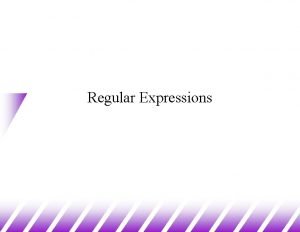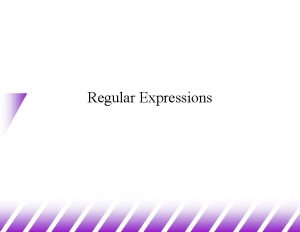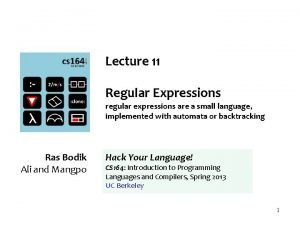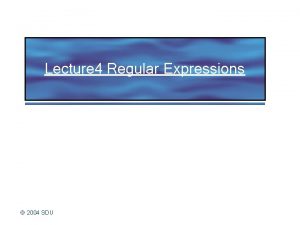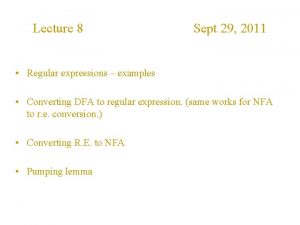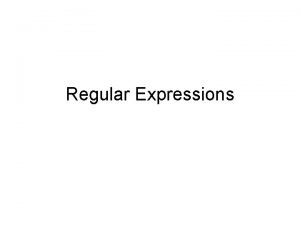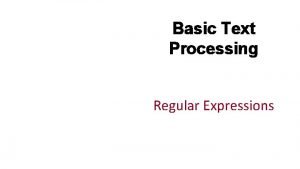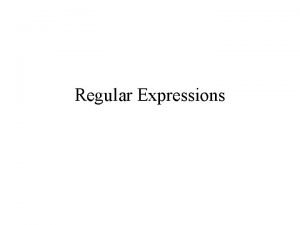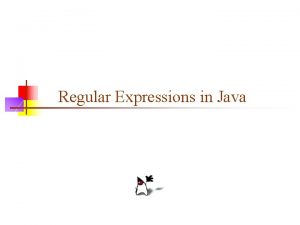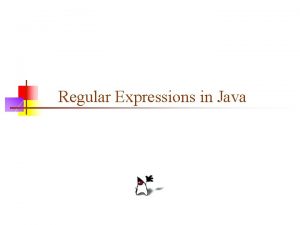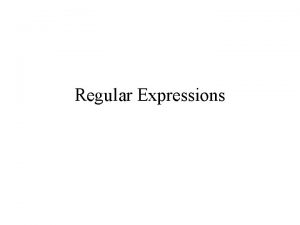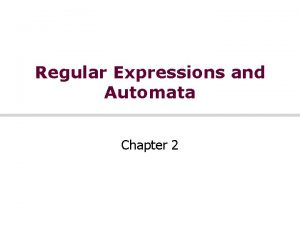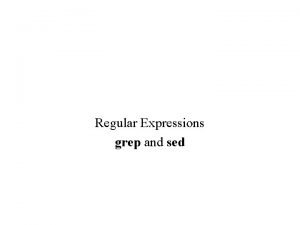Lecture 5 Sept 06 2012 Regular expressions examples




















- Slides: 20

Lecture 5 Sept 06, 2012 • Regular expressions – examples • Converting DFA to regular expression. (same works for NFA to r. e. conversion. ) • Converting R. E. to NFA

RE’s: Introduction v. Regular expressions are an algebraic way to describe languages. v. They describe exactly the regular languages. v. If E is a regular expression, then L(E) is the language it defines. v. We’ll describe RE’s and their languages recursively.

RE’s: Definition v. Basis 1: If a is any symbol, then a is a RE, and L(a) = {a}. v. Note: {a} is the language containing one string, and that string is of length 1. v. Basis 2: ε is a RE, and L(ε) = {ε}. v. Basis 3: f is a RE, and L(f) = { }.

RE’s: Definition – (2) v. Induction 1: If E 1 and E 2 are regular expressions, then E 1+E 2 is a regular expression, and L(E 1+E 2) = L(E 1) L(E 2). v. Induction 2: If E 1 and E 2 are regular expressions, then E 1 E 2 is a regular expression, and L(E 1 E 2) = L(E 1)L(E 2). Concatenation : the set of strings wx such that w Is in L(E 1) and x is in L(E 2).

RE’s: Definition – (3) v. Induction 3: If E is a RE, then E* is a RE, and L(E*) = (L(E))*. Closure, or “Kleene closure” = set of strings w 1 w 2…wn, for some n > 0, where each wi is in L(E). Note: when n=0, the string is ε.

Precedence of Operators v. Parentheses may be used wherever needed to influence the grouping of operators. v. Order of precedence is * (highest), then concatenation, then + (lowest).

Examples: RE’s v. L(01) = {01}. v. L(01+0) = {01, 0}. v. L(0(1+0)) = {01, 00}. v. Note order of precedence of operators. v. L(0*) = {ε, 0, 000, … }. v. L((0+10)*(ε+1)) = all strings of 0’s and 1’s without two consecutive 1’s.


Theorem: A language is regular if and only if it is accepted by a regular expression. Proof: Show to convert from regular expression to NFA and vice-versa. Let L be accepted by a regular expression. We prove that it is regular, i. e. , there is a NFA for L. Cases to consider: (1) empty-set (2) single symbol {a} (3) {e} (4) (a) R 1 + R 2 (b) R 1. R 2 (c) R 1* (1), (2) and (3) are easy base cases. For (4), inductively construct NFA’s for R 1 and R 2, and from it construct an NFA for R.


Induction step is shown in the next theorem.

Theorem: The set of Regular languages is closed under the three operations concatenation, union and Kleene star. Proof: (by construction) Union: Given DFA’s M 1 and M 2 for L 1 and L 2, we design a NFA for L 1 U L 2. s 1 e s 2 M 1 M 2

Concatenation:


Concatenation – Formal Proof

Closure under Kleene star – informal proof DFA for a language L is shown on the left. The NFA for L* can be constructed as shown on the right.


Converse is shown as follows: Given a DFA (or NFA), we remove states one by one until we have one state left. At this point, we can write down the regular expression. The idea is to use generalized NFA, one in which the transitions are labeled not by a single symbol, but by a regular expression. Example of GNFA:

Conversion from DFA to regular expression Key step: how to remove a state of a GNFA

So far, we have seen how to design DFA, NFA or regular expressions for various languages. We also learned how to convert: • e-NFA • NFA -> DFA • DFA regular expression • Regular expression NFA
 01:640:244 lecture notes - lecture 15: plat, idah, farad
01:640:244 lecture notes - lecture 15: plat, idah, farad Un, deux, trois, quatre, cinq, six, sept, huit, neuf
Un, deux, trois, quatre, cinq, six, sept, huit, neuf La guerre de sept ans
La guerre de sept ans La guerre de sept ans
La guerre de sept ans 7 mountains of jerusalem
7 mountains of jerusalem La pluie pierre gamarra
La pluie pierre gamarra Ecrivez les sept jours de la semaine
Ecrivez les sept jours de la semaine Sept commandements
Sept commandements Cnn10 september 7 2021
Cnn10 september 7 2021 Sept heure moins le quart
Sept heure moins le quart Accu poole sept
Accu poole sept Suture to stabilize suffix
Suture to stabilize suffix Sept
Sept I sept
I sept Sept comme setteur questionnaire
Sept comme setteur questionnaire Xkcd 208
Xkcd 208 Simplifying rational expressions
Simplifying rational expressions Perl 5 regular expression
Perl 5 regular expression Regular language
Regular language Regular expressions wikipedia
Regular expressions wikipedia Regular expressions
Regular expressions

